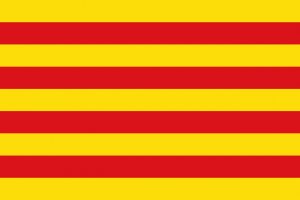Language/Catalan/Culture/History-and-Geography
| ◀️ Travel Phrases — Previous Lesson | Next Lesson — Traditions and Celebrations ▶️ |
Introduction[edit | edit source]
In this lesson, we will explore the rich history and diverse geography of Catalonia. Catalonia is a region in northeastern Spain, with its own distinct culture, language, and identity. Understanding the history and geography of Catalonia is crucial for gaining a deeper appreciation of the Catalan language and its unique characteristics. In this lesson, we will delve into the political status of Catalonia, its regional identity, and its rich cultural heritage. By the end of this lesson, you will have a comprehensive understanding of Catalonia's historical and geographical significance.
Political Status[edit | edit source]
Catalonia has a complex political status within Spain. It is an autonomous community with its own government, known as the Generalitat de Catalunya. The Generalitat has the power to legislate and govern in certain areas, such as education, healthcare, and culture. However, Catalonia is also subject to the central government of Spain, and there have been ongoing debates and discussions about the level of autonomy that Catalonia should have.
One significant event in recent history that highlighted Catalonia's desire for greater autonomy was the referendum on independence held in 2017. The Catalan government called for a referendum on whether Catalonia should become an independent republic. However, the Spanish government deemed the referendum illegal, leading to a period of political unrest and protests in Catalonia. The referendum resulted in a majority of votes in favor of independence, but it did not lead to Catalonia officially seceding from Spain.
Regional Identity[edit | edit source]
Catalonia has a strong regional identity, shaped by its history, language, and culture. The Catalan language, which is closely related to Spanish and French, is one of the main pillars of Catalan identity. Catalan is spoken by the majority of the population in Catalonia and is recognized as an official language in the region.
Catalonia also has its own unique customs and traditions. One example is the Castells, which are human towers built by groups of people during festivals and celebrations. These towers can reach impressive heights, with participants climbing on top of each other to form a tower structure. The Castells are not only a physical spectacle but also a symbol of unity and cooperation in Catalan culture.
Another important aspect of Catalan regional identity is its cuisine. Catalonia is known for its diverse gastronomy, with dishes such as paella, escalivada, and crema catalana. Catalan cuisine is characterized by the use of fresh, local ingredients, and the region is home to numerous Michelin-starred restaurants.
Cultural Heritage[edit | edit source]
Catalonia has a rich cultural heritage that is deeply intertwined with its history and geography. The region is home to numerous architectural masterpieces, including the iconic Sagrada Familia in Barcelona, designed by renowned architect Antoni Gaudí. Gaudí's unique architectural style, characterized by its use of organic shapes and vibrant colors, has become synonymous with Catalan culture.
Catalonia is also known for its vibrant arts scene. The region has produced many influential artists, writers, and musicians throughout history. One notable Catalan artist is Joan Miró, whose abstract and surrealistic paintings have gained international recognition. Miró's works often incorporate bright colors and whimsical shapes, reflecting his unique artistic vision.
The region's geographical diversity has also played a significant role in shaping its cultural heritage. Catalonia is home to stunning natural landscapes, including the Pyrenees mountains, picturesque coastal areas, and fertile plains. These diverse landscapes have inspired Catalan literature, music, and art, and have become an integral part of the region's cultural identity.
Exercises[edit | edit source]
1. Match the following Catalan dishes with their English translations:
| Catalan | Pronunciation | English |
|---|---|---|
| Paella | /paˈeʎa/ | A. Grilled vegetables |
| Escalivada | /əskəliˈvaðə/ | B. Rice dish with saffron |
| Crema catalana | /ˈkɾɛmə kətəˈɫanə/ | C. Catalan cream dessert |
| Calçots | /kəɫˈsɔts/ | D. Charcoal-grilled leeks |
2. True or False: The Castells are a traditional Catalan dance.
- False: The Castells are human towers built during festivals and celebrations.
3. Discuss the political status of Catalonia within Spain. What are the main points of contention?
4. Research and write a short paragraph about a famous Catalan artist or musician.
Conclusion[edit | edit source]
In this lesson, we have explored the history and geography of Catalonia, gaining insight into its political status, regional identity, and cultural heritage. Catalonia's unique position within Spain, its strong regional identity, and its rich cultural heritage make it a fascinating region to study. By understanding the history and geography of Catalonia, we can develop a deeper appreciation for the Catalan language and its cultural significance. In the next lesson, we will continue our exploration of Catalan culture by diving into its traditions and celebrations.
Sources[edit | edit source]
Other Lessons[edit | edit source]
- Catalan celebrations, traditions and customs
- Artistic movements and traditions in Catalonia
- The geography and history of Catalonia
- Andorra History
- Catalan identity and linguistic activism
- Major artists, architects, and musicians
- Catalan cinema and popular culture
- Major writers, poets, and literary works
- Traditions and Celebrations
| ◀️ Travel Phrases — Previous Lesson | Next Lesson — Traditions and Celebrations ▶️ |

